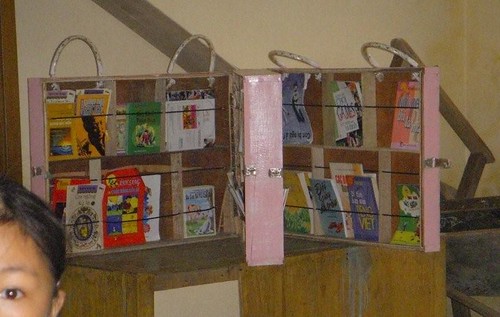Thursday 17 July 2008
Thien An Orphanage
The orphanage has approximately 35 children, and also takes care of pregnant local women who would otherwise abort their pregnancies. The orphanage appears to be well managed, although it suffers from the usual lack of resources.
It was very hot on the day that we visited (it usually is hot there) and the electricity was out across the region. Apparently the electricity doesn't work for a number of hours every day, so the children have to suffer in the extreme heat. The orphanage is trying to raise money to pay for a generator so that they can runs fans all day in the nurseries and elsewhere. We were told that they need a 10 kilowatt generator which will cost about $USD1200. We are looking to raise the money for this generator for the orphanage. If you would like to contribute, please email us at vietnanon@yahoo.com and we will co-ordinate with the orphanage.
The orphanage also is looking for funds to help take care of the pregnant mothers and babies. It costs $200-$300 to see each pregnancy through to the end. It costs $30/month to care for each child in the orphanage.
We plan to visit Thien An Orphanage again in the next week or so.
We told Sister Mary that we would write about the orphanage on the blog and she sent us a personal message to be posted here, describing the activities of the orphanage and some of her needs. You can read the letter here (PDF). You can see some photos of the orphanage and her residents here and here.
(* For the record, we do not endorse any religions on this blog, and we have reported on our visits to Buddhist, Catholic and Government orphanages and organizations)
Sunday 13 July 2008
Mekong Delta
The group was in Vietnam for a number of projects, including the delivery of 180 bicycles to needy children so that they can ride, rather than walk, the long distances to school. The group also built and donated some houses, and housing improvements, to some people in need.
Here is a pic from a recent GCSF event when a bunch of bikes were given to school kids.
 The group invited us to join them one day on a visit to Mekong Delta to witness a small ceremony when they handed over a new home to a poor family in the village of Tan Thanh. Dr Phu said a few words (pictured below), in Vietnamese of course, to mark the occasion, as did the woman of the household (pictured left, standing). It was touching, despite the fact that we couldn't understand the words.
The group invited us to join them one day on a visit to Mekong Delta to witness a small ceremony when they handed over a new home to a poor family in the village of Tan Thanh. Dr Phu said a few words (pictured below), in Vietnamese of course, to mark the occasion, as did the woman of the household (pictured left, standing). It was touching, despite the fact that we couldn't understand the words.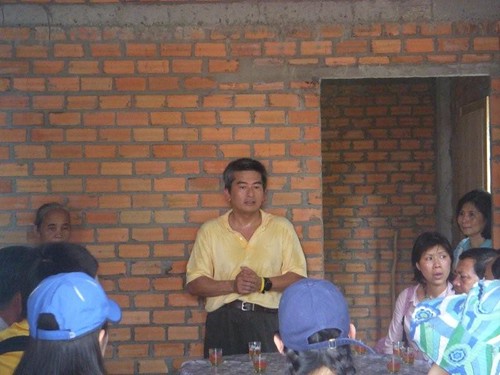 Some of the village kids came to see what the commotion was all about:
Some of the village kids came to see what the commotion was all about: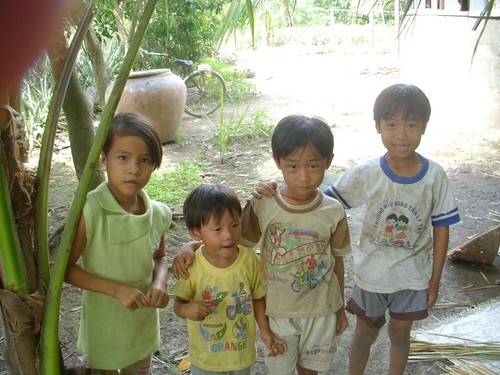
After the ceremony, we visited a house in another village which was to have a floor added (the floor is currently just the dirt on the ground.) The man of the house is also having some health difficulties and in need of a hernia operation which the group is trying to facilitate.
After the group had finished their work for the day, we all jumped on a boat in the Mekong for some lunch and recreation, hopping from island to island. First stop was a delicious lunch in a stilt house, with seafood and chicken, Jack fruit, and the ubiquitous warm beer.

Yummm, grilled fish.
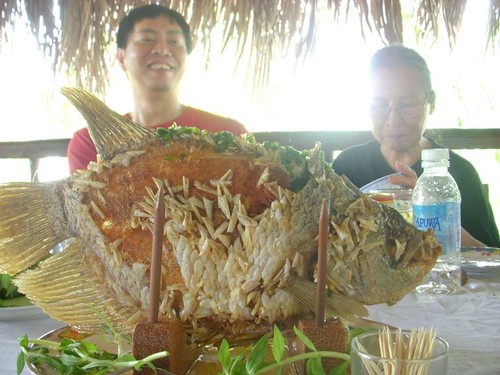 And here is some Jack Fruit on a tree. Apparently it tastes great in a fruit shake for breakfast.
And here is some Jack Fruit on a tree. Apparently it tastes great in a fruit shake for breakfast.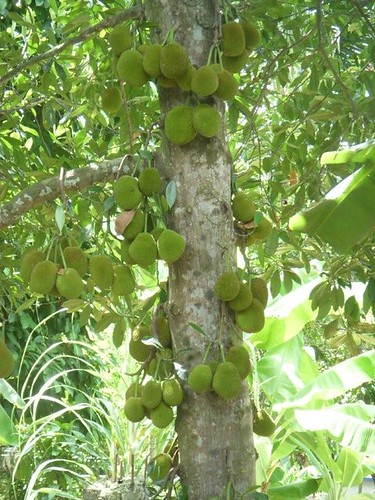
This pic was snapped from a boat in the river after lunch. These local lads were swimming in the river and enjoying the shade under the bridge... It sure gets hot in the Mekong...

After lunch we visited another island with a (very manual) coconut candy factory, and shop for tourists. These women are hand-wrapping the candy.

Our last stop was on another island which featured an orchard with various fruits where we were treated to a recital of old Vietnamese songs, sung by members of the family who run the orchard, while we feasted on fresh fruit dipped in chili salt.
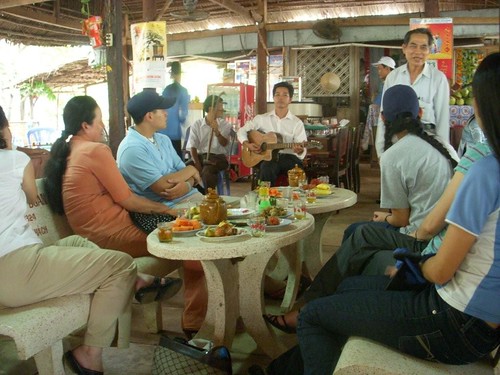 Some kids watching the performance:
Some kids watching the performance: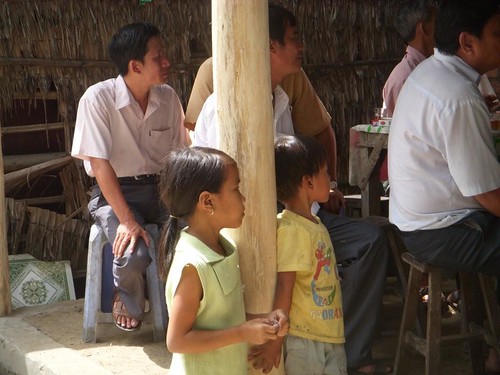
After the performance, we took a stroll through the orchard and climbed into little boats on a little river that runs through the island. This pic shows our oars-woman at the front of the boat, who is five months pregnant.
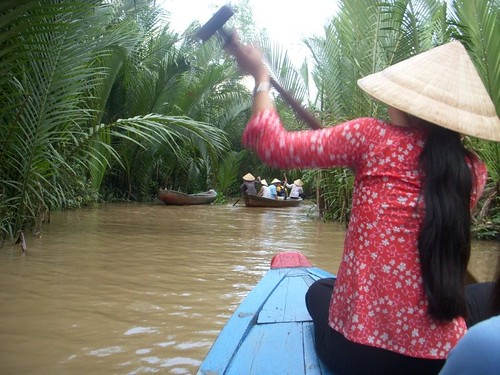
Thanks to Doctor Phu and friends for sharing their day with us.
-----------------------
For more background, these two articles (1,2) from earlier in the year describe some of the good work that GCSF is doing in Vietnam, while this article describes the recent trip by Dr Phu and his friends and family. Another organization represented in the group was Viet-Nam Assistance for the Handicapped (VNAH) which provides wheelchairs and prosthetic limbs. The group also lobbies for rights for the handicapped here, for example, ensuring that building codes include wheelchair access.
Saturday 12 July 2008
Phu My Orphanage, HCMC
The orphanage appeared well managed, like all of the orphanages we have seen in Vietnam, although the caregiver-to-child ratio is much higher than we have seen, with 400 children and only twenty caregivers. Given that many of the children at the orphanage have significant problems and many are permanently confined to bed, the orphanage could use a lot more staff.
We spoke with the Vice-Director, Sister Marie Nguyen Thi Hon, and asked her what type of volunteers she needed, expecting that she'd tell us that she needed qualified medical personnel. She told us that they have doctors there at the orphanage every day, and therefore they don't require doctor volunteers, although physiotherapists would be a great help. What they really need is simply for volunteers to come and spend time with the children, perhaps pushing a wheelchair around in the garden area, reading a book to the children, or pushing a swing etc. The most common health issues that the children face are bed sores, choking syndrome and bone weakness.

 (The images are from this web page)
(The images are from this web page)The orphanage also maintains two other venues; a 'daycenter' which houses 200 kids during the day so that parents are able to go to work, and a 'teaching farm', 200km north of Saigon, where young adults are taught farming skills so that they can re-integrate and become self-sustaining. We didn't get a chance to se that, but it sounds like an interesting idea.
If you are visiting Saigon and would like to help out for a day, or a month, or on a regualr basis, the address of the orphanage is 153 Xo Viet Nghe Tinh Str, Binh Thanh District, HCMC. ph: 08 899 6563. Email: mocoithinghe@vnn.vn
Friday 4 July 2008
Mobile Libraries Project
The Mobile Library concept has been running since 1979 in Thailand. In the last few years, Le Ly Hayslip and the Global Village Foundation have been placing Mobile Libraries in schools in Quang Nam Province in Central Vietnam. We visited some of those schools in April and wrote about the experience here.
Global Village Foundation will now implement the Mobile Library program in Binh Thuan Province, and we'll be there to help!
The Need
Global Village Foundation describes the need on their website:
We hope to provide assistance in addressing two major issues that we have identified in Viet Nam, especially in the rural, central region. The first is the literacy problem, and the second is the shortage of books and other reading materials to be used as teaching tools.
[...]
The Vietnamese education system divides primary schools into Main and Subordinate schools. The Main primary schools receive most of the attention and funding, which means that each school is equipped with a library, but not the Subordinate schools. Our aim is, therefore, to provide these Subordinate primary schools with Portable Library Units filled with books so that children attending these schools will not be left behind, educationally speaking.
The Mobile Libraries
The Mobile Library units are simple boxes which hold approximately 250 books each.
Here is a picture of one of the Library units ready to be moved or stored.
And here is a Library unit displaying the books in a classroom.
And here is the Mobile Library in action in the classroom.

Each school in the program is given a Mobile Library Unit at the beginning of the semester, and the children can read the 250 books over the semester (approximately 4 months). At the end of the semester, the Mobile Library Units are rotated through the participating schools, resulting in a fresh batch of 250 books in each school. The rotation program is based on a 2 year cycle, such that each child will have access to nearly 1000 books over the cycle (4 semesters).
The books vary in topic and grade level, and include both Vietnamese and English language titles. The book list is developed in conjunction with the Education department.
Donations
Please consider donating to help us help the Vietnamese children. Donations are tax-deductible.
Contact us at VietnamAnon@yahoo.com, or Le Ly Hayslip at Info@globalvillagefoundation.org
Here is a short clip of two of the libraries in action in a class room from our visit earlier this year. It's pretty simple, and pretty effective, right?
We'll keep you posted as things progress.
Saturday 31 May 2008
Trip overview
Thank you so much for sharing our trip with us. We hope that you've enjoyed our blogging along the way.
We met a lot of great people in the last few months as we traveled from Hanoi to Ha Long Bay to Sapa to Hoi An to Dalat to Phan Thiet. We hope that you've enjoyed meeting some of them too.
We interviewed Duc and we visited the Pagoda Monastery (post 1, 2) in Hanoi. We posted some pictures of Ha Long Bay and Sapa (more). We visited a Black H'Mong school near Sapa (more) - and some other schools (more)in the same region.
We interviewed a bunch of people in Hoi An: Bruce & Elaine, Le Ly Hayslip (more, more and more), Josh Solomon and Karen Leonard. We also had a post on Agent Orange.
We even wrote a post or two about the delicious Vietnamese food.
Thanks also to Vinh, Hung, Le, Cy, Trung, Lan and the many others who made our trip so memorable... So memorable, in fact, that we'll be back in Vietnam - soon! How soon? By the end of June.
We have a new project and are rushing to finalize the details, and the requisite fund-raising. We'll have a new post up soon with more details. You might be able to help...
More soon.
Monday 19 May 2008
Agent Orange, Apocalypse Still
The father worked for the American military during the Vietnam War, running missions searching for Viet Cong after the Americans defoliated a forest by dumping Agent Orange from the air. The father still has his official papers from the US military.
Given our interest in Agent Orange, Le Ly arranged for us to visit the family at their home in a remote village near Hoi An. After a 3 hour drive, and a one-hour walk through the rice paddies under the hot Vietnamese sun, we interviewed the parents and met their sons.
Firstly, for some background about Agent Orange in Vietnam, please read "Apocalypse Still" by investigative reporter Robert Dreyfuss in Mother Jones in 2000:
"In the years since the war's end, however, the reality of America's chemical warfare in Vietnam's forests and rice paddies has slowly begun to unfold. Though thousands of American veterans of the war now receive government compensation for illnesses linked to Agent Orange, the United States has yet to accept responsibility for the devastating effects of its campaign on Vietnam. Millions, perhaps tens of millions of Vietnamese, combatants and civilians alike, were showered with Agent Orange, and then lived, worked, and breathed amid the residue of an especially virulent form of dioxin, a byproduct of one of the defoliant's chemical components. This poison, a carcinogen once described as "the most toxic molecule ever synthesized by man," infiltrated the country's water and soil, entering the food chain and accumulating in people's tissues, even passing from mother to child through breast milk. According to Vietnamese estimates, the millions of gallons of Agent Orange that soaked the southern half of Vietnam during the 1960s eventually killed or injured 400,000 people and reportedly contributed to birth defects in 500,000 children. Chillingly, its effects are still being felt, not only among older Vietnamese, whose cancers and other illnesses are often linked to Agent Orange, but among second- and third-generation children of the war, whose twisted bodies and crippled minds bear silent witness to the scourge."Please read the rest, which Dreyfuss calls "One of my most important pieces. " (see here (pdf) for the version of the article with photos)
The US government is still denying the extent of the problem, their culpability, and their liability. There are some positive-looking moves, however, with the US House Foreign Affairs holding some hearings last week called "Our Forgotten Responsibility: What Can We Do To Help Victims of Agent Orange?"
In our interview, the parents described their ordeal: When the twins were 3 years old, the parents realized that they were having developmental problems and took them to all the major hospitals in Central Vietnam for help. They were told that they only have two options; either take the children to a foreign country to get some medical treatment, or simply take the children home and try to look after them.
The family couldn't afford to travel to seek medical attention, so the twins, now 28 years old, have been at home ever since. The twins can't feed themselves, and they can't talk. Their entire existence is lying on a shared, cane bed which has slits in it so that their bodily waste can fall through to the floor.
The twins appear to be able to communicate with each other via sounds and eye contact, and appeared to know that we were in their room, with one of them appearing to show us his bed sores.
The parents are both 60 years old and aren't sure how long they will live. One of their main concerns, now, is that there isn't anybody to look after their sons when the parents die.
We'd like to thank the family for sharing their story with us.
If you'd like to help the family, please contact us at vietnanon@yahoo.com or contact Global Village directly: info@globalvillagefoundation.org
Tuesday 29 April 2008
Food for Thought (part 2)
We had planned to take at least one cooking class while in Vietnam, and after some research, decided that Hoi An sounded like the best place... The most famous cooking school there is Red Bridge Cooking School, but after taking a closer look, we decided to attend the competing cooking school at Morning Glory Cafe. There were several reasons for that: 1. We dined at Morning Glory frequently and loved their food. 2. The classes seemed a bit smaller and more personal. 3. Their prices were more reasonable. 4. It was highly recommended by the locals.
We booked a class one day prior to the session, and showed up there the following morning at 10am. We were a little early, so we sat in their outdoor setting and sipped our strong Vietnamese ice coffee and engaged in some people watching while we waited for the other attendees to arrive.
Once everyone arrived, we were taken upstairs to their cooking demonstration room. The entire set-up was very impressive - it was spotlessly clean, with cooking facilities for each participant, and a good view of the instructor - both directly, and via an angled mirror behind her. Each cooking station had a gas stove top, preparation mat, and cooking utensils, all set up...


When we arrived, each station had one white Vietnamese eggplant in the middle of the preparation mat, so we cleverly figured out that our first dish was going to be eggplant related!
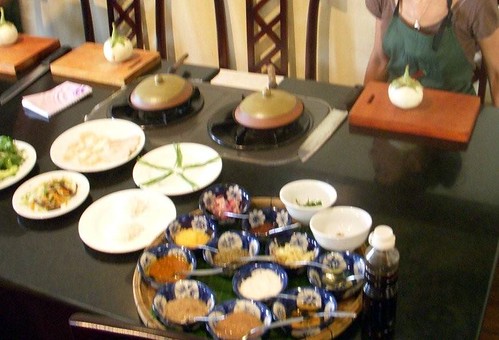
Our instructor, Ms Lu, has been working at the school for over 10 years since her early teens. Her English was very good, and we could all follow her instructions clearly.
Our first lesson started with an introduction to Vietnamese white eggplant, and how to trim and slice it appropriately, soak it in salt water for 10-15 minutes to remove bitterness, how to fry, flavor, and finally present it artfully...

Here is the recipe for delicious & healthy fried white eggplant:
--------------
Fried White Eggplant
Serves: 1
Preparation Time: 45 mins
Cooking Time: 6 mins
Ingredients
1 small white egpplant
1 bowl water (cold)
1 pot water (boiling)
2 tbls vegetable oil
2 tsps Light soy sauce
1 tsp Brown sugar
1 tbls Green onion (1 cm round)
12 tsps Fish sauce
1 tsp garlic (chop finely)
1 tsp chili (chop fine)
Method
* Thinly slice eggplant halfway down. Flip over, rotate 90 degrees, repeat the slicing
* Soak eggplant in cold salted water for 30 mins
* Place eggplant in boiling water for 7 minutes. Place a heavy plate on top of eggplant to ensure that it is fully submerged.
* Remove eggplant from water and place between the bottom of two plates and squeeze, draining excess water from inside eggplant
* In a saute pan, heat 1 tbls vegetable oil until hot. Place eggplant in pan. Cook 2-3 minutes on each side. When done, it should be golden brown and crispy on the outside
* Mix soy sauce and sugar together
* In saute pan, heat 1 tbls vegetale oil until hot. Add green onion and fry for 2-3 minutes, adding fish sauce at the end of cooking time.
* Put eggplant on plate, top with fried green onion and drizzle soy sauce around
* Mix garlic & chili, place in center, and serve.
-------------
Next we were taught how to make the famous Vietnamese Fresh Spring Rolls. The instructor's assistants placed fresh rice papers, a plate of washed and chopped herbs, slices of roast pork, halved pre-cooked shrimp, bean sprouts, rice noodles, spices and sauces for the dipping sauce on each cooking station, and we began rolling... Note the chives sticking out the top!

----------------
Fresh Spring Roll
Servings: 2
Preparation Time: 3 Minutes
Ingredients
* Rice
* Raw Herb (lettuce, basil, coriander, chives)
* Marinated Pork loin - baked or steamed
* Boiled Shrimp, cut in half
* Rice Paper
Method
* Wet your rice paper both sides with wet towel
* One big chopstick of herbs on rice paper and a chopstick of noodle on top, 2 slices of pork loin, 2 slices of shrimp
* Cover noodle & herbs completely
* Fold the side of the rice paper
* Place chives decoratively, sticking out of end of roll
* Roll up rice paper to the end
* Serve with peanut sauce
---------------------
After the fresh spring roll, we began our instruction on two famous Vietnamese salads (it can also be considered an appetizer since it contains meat): Green Mango Salad and Green Papaya Salad. Since there is very little or no variation between the two, we chose to give you the Green Mango Salad recipe below.
Our instructor also showed us a whole banana flower, which is the main ingredient on the Banana Flower Salad, one of our favorite dishes in Vietnam.

Back to the Green Mango & Papaya Salads... Before we get to the recipe, we want to take the time to tell you about a great little tool that is used for preparing items for salads. Here is a picture - it's about 8 inches long.
 And here's a close-up of the 'pointy end.' When you drag those little loops down the side of a fruit, the result is thin strips of the mango/ papaya etc that can go directly into the salad.
And here's a close-up of the 'pointy end.' When you drag those little loops down the side of a fruit, the result is thin strips of the mango/ papaya etc that can go directly into the salad.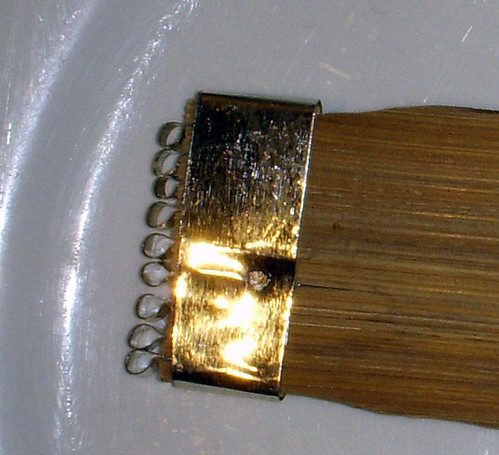 Here is Lu using the tool.
Here is Lu using the tool.
Here's the recipe
------------------
Servings: 10
Prep time: 10 minutes
Cooking time: 10 minutes
* 1 tbl Red onion (chop fine)
* 3 tbl Lime juice
* 1 tsp White sugar
* 1 tsp chili (chop fine)
* 1 tsp fish sauce
* 1 tsp garlic (chop fine)
* 1 cup Roasted peanuts (crush)
* 200 gram green mango
* 1/2 cup mint leaves
* 1/2 cup basil leaves
* Heat vegetable oil in skillet until hot
* Add red onion and saute until golden brown & set aside
* In a bowl, combine lime juice, white sugar, salt, chili, fish sauce, garlic, and half of the roasted peanuts
* Mix the dressing with the green mango, allowing it to soften and the dressing to drain through
* Mix half of the mint and half of the basil into the golden brown red onion and vegetable oil, making sure it has cooled to a warm temperature, ensuring the herbs will not turn black
* Place salad on plate. Top with red onion & herb mixture first, then top with the remaining peanuts, mint and basil.
(Hint: carrot & cucumber can be used instead of green mango.)
-------------
Next up was the famous Hoi An pancake - which is made with a rice flour mixture, no dairy. We don't have the recipe for this one, unfortunately. We cooked these at our cooking station, with a little help from Lu. The instructions were only to cook the pancake for 10 seconds in the little pan before adding some bean sprouts and some herbs, and then folding in half - although in reality, the pancakes were on the burner for at least 30 seconds - even when Lu was demonstrating...
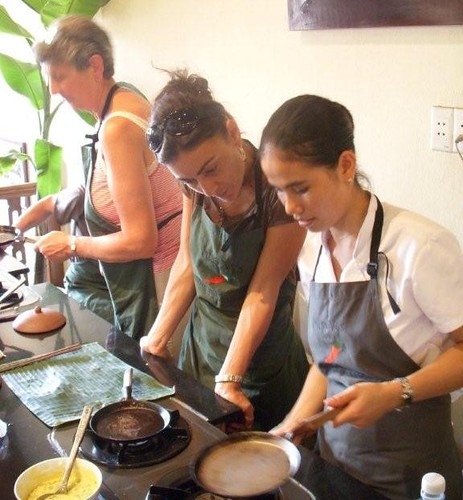
And here's the end product. The white triangles at the top of the plate are rice paper which you wrap around the pancake before consuming.
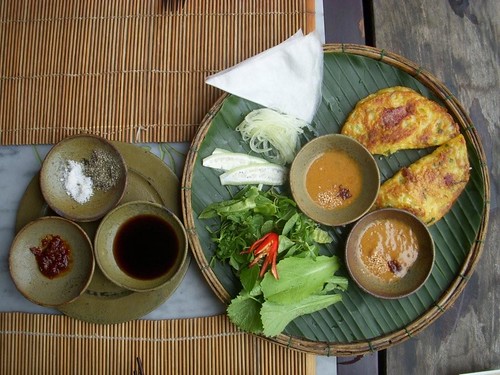
Next up: Main Course. We were asked if we were vegetarian - and 'vegetarians' were tasked with cooking one of our favorite dishes in Hoi An - fish with turmeric, wrapped in banana leaves. We ate this dish as often as possible - our favorite was at Cargo Club.
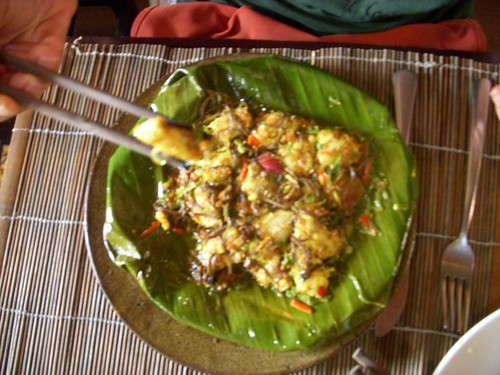
--------------
Prep time: 30 minutes
Cooking time: 12-15 minutes
* 1 tbls wood ear mushrooms (slice thin)
* 1 tbls Turmeric (grated fresh or powder)
* 200 grams white mackerel (cubed)
* 1 tbls vegetable oil
* 1 tsp fish sauce
* 1 pinch salt
* 1 pinch black pepper
* 1 pinch brown sugar
* 1 pinch chili (chop fine)
* 1 tsp garlic (chop fine)
* 1 tsp red onion (chop fine)
* 1 tbls Green Onion (1cm round)
* 6 banana leaves
Method
* Soak vermicelli noodles and wood ear mushroom in cold water for 10 mins to soften
* Cut mackerel into evenly sized small cubes
* In a saute pan, heat 1/2 tbls vegetable oil until hot, add turmeric and cook for 3 mins
* In a bowl, mix the fish with remaining vegetable oil, fish sauce, salt, black pepper, brown sugar, chili, garlic, red onion, green onion, and turmeric once it has cooled.
* Take two pieces of banana leaf and arrange on top of one another to create an 8-point star
* Lay fish down, centered just below the middle of the banana leaves
* Begin folding from the bottom up, then one side at a time, close by folding top down
* With remaining leaves, wrap the envelope. These leaves will char when cooking.
* Place on grill, cooking 5-7 minutes on each side
* To serve, remove outer charred leaves and place green leaf with fish on it onto the plate, folding excess leaf under the plate
(Hint: If using powdered turmeric, only toast it lightly before adding to fish.)
----------------
The 'non-vegetarians' in the class cooked BBQ chicken on skewers. As you can see from the recipe below, you just toss all the spices into a bowl with some oil, and marinate the chicken and then threading a skewer through the chicken. The only trick was knowing which spice was which (no labels)!
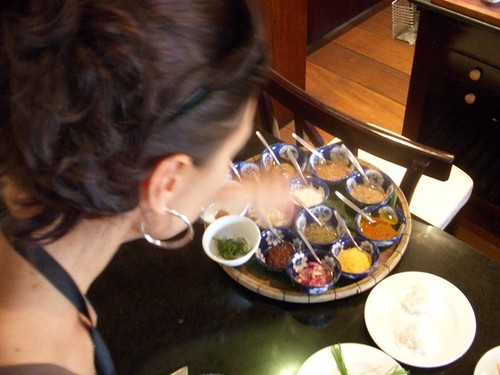
Here is the end product, presented artfully, as always.
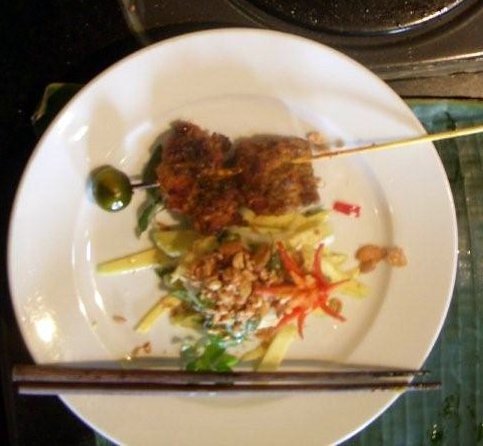
-------------------
Prep time: 30 minutes
Cooking time: 15 minutes
Ingredients:
* 10 skewers
* 200 grams Dark chicken meat (cubed)
* 1 tsp Vegetable oil
* 1 tbls galangal (chop fine)
* 1 tbls Lemongrass (chop fine)
* 30 lime leaves
* 1 tbls garlic (chop fine)
* 1 tbls chili (chop fine)
* 1 tbls shallot (chop fine)
* 1 pinch 5 Spice
* 1 tsp fish sauce
* 1 tsp brown sugar
* 1 tsp salt
* 1 tsp black pepper
* Finely chop 5 lime leaves
* Marinate chicken in oil, all the spices, and chopped lime leaves
* Let stand for 15 minutes, or up to several hours
* Fold chicken cubes between lime leaves
* Place two pieces of chicken on each skewer
* BBQ chicken, rotating every 2 minutes until done cooking
* Plate and serve
(Hint: Lime leaves should be young. This means they will be light in color and soft.)
-------------------
Actually, we didn't actually cook these dishes (the chicken and the fish) - we only prepared them. When we were done preparing, the assistants came around and collected everyone's meals and did the actual cooking in another room.
When our class was finished, we all sat in the dining room and were served the feast that we had made - it was delicious, and particularly satisfying because we made it ourselves! Hopefully we'll be able to perfectly recreate the dishes at home without Lu and her team looking over our shoulder...
Next time you find yourself in Hoi An, consider the Morning Glory cooking school - even if you don't consider yourself much of a chef! It's lots of fun. You'll also receive a booklet with lots of recipes, and one of those handy salad tools pictured above.
Monday 28 April 2008
Food for Thought (part one)
We know that many of you have been anxiously awaiting our food blogging - well, here is the first post.
We've decided to have 3 food-blogging posts - the first will be about the basics: ingredients, cooking methods & produce. We're not food experts, of course, so this will just be our cursory observations.
Rice is, of course, the main staple in Vietnam - not only as the rice that we know, but also rice paper, rice noodles, rice crepes, rice crackers, rice wine, rice gelatin - and we've probably forgotten a few others... The rice paper comes in 3 or 4 different forms; the soft fresh form for making fresh spring rolls; another variation for making fried spring rolls, and another which is grilled or fried, similar to pappadam, like a cracker, which is served as a side dish to accompany salads and certain appetizers...
Here are many of the rice noodle forms in the Hoi An market
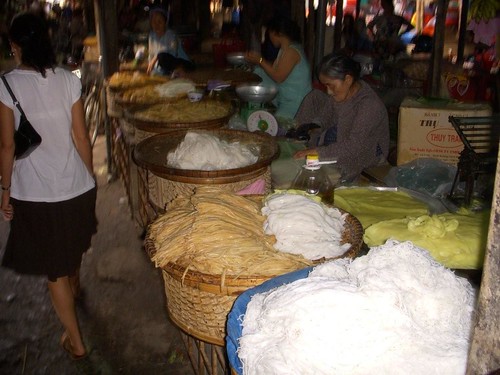 Rice paper used for fresh spring rolls - filled with bean sprouts, mint, shrimp, roast pork, and other vegetables...
Rice paper used for fresh spring rolls - filled with bean sprouts, mint, shrimp, roast pork, and other vegetables...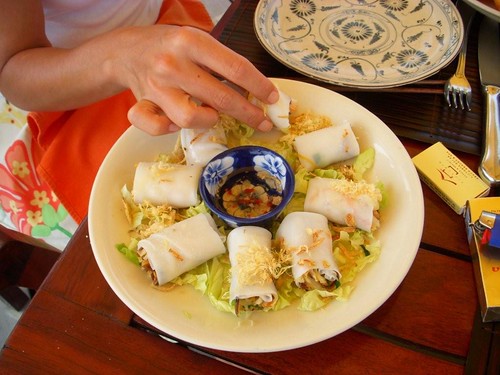 Check out the big bowl of rice vermicelli noodles, served to accompany meals in a village house where one of our new Vietnamese friends lives (more on this later!)
Check out the big bowl of rice vermicelli noodles, served to accompany meals in a village house where one of our new Vietnamese friends lives (more on this later!)
Rice, pappadam style
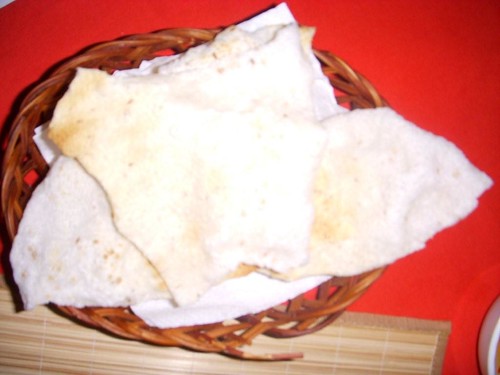 Rice is also used to make rice wine and rice whiskey. For some reason, it is often sold in glass jars with various snakes floating inside!
Rice is also used to make rice wine and rice whiskey. For some reason, it is often sold in glass jars with various snakes floating inside!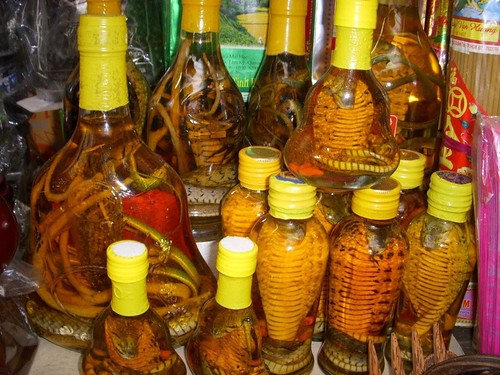
Vegetables are also very popular - the most common (almost as common as rice) is water spinach - a.k.a. Morning Glory - a semi-aquatic tropical plant which "flourishes naturally in waterways and does not require much if any care." It is most commonly served simply sauteed with garlic, garnished with some hot chili pepper, and maybe drizzled with a dash of nuoc mam (fish sauce) - it is absolutely delicious. Apparently it is expensive in the West because it needs to be washed repeatedly to get rid of all the mud, dirt, sand, silt and whatever else it grows in...
Morning Glory (water spinach), served at one of our favourite restaurants in Hoi An, called... Morning Glory! It is sauteed with large sweet garlic, and on the top, sprinkled with fried shallots, chopped fresh red chili pepper, and drizzled with fish sauce (nuoc mam) and a dash of sesame oil. It really is delish!
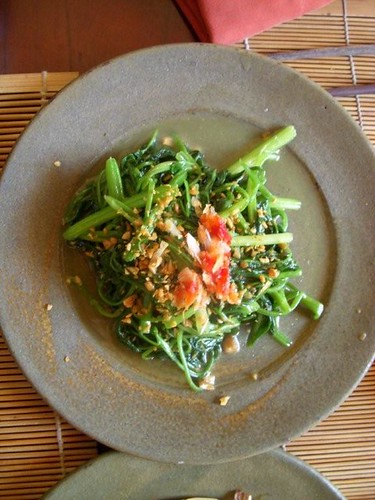
Eggplant is another popular vegetable - they use a variety of eggplant species - the most common is the Asian eggplant called 'white eggplant' - others include Japanese eggplant and occasionally Italian eggplant.
Fried white eggplant - another of our favorites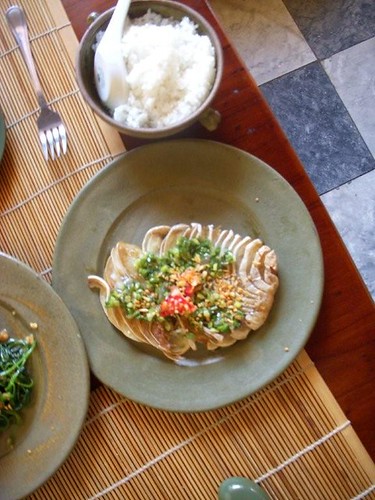
The markets are colorful, with colorful characters, and fresh vegetables everywhere...

Tofu is another popular dish, made out of soybean. Tofu is popular among the many vegetarians in Vietnam - and is sometimes used as a meat-substitute, leading to some bizarre situations. When we visited a Buddhist orphanage in Hanoi, we were invited for 'vegetarian' lunch. When we sat down at the table, there were a dozen or so dishes that resembled various meat products, all made out of tofu (we worked out later) - for example, tofu shaped (and sliced) like fried squid, tofu-shaped like fried chicken pieces, tofu shaped liked pigs trotters etc. Each dish was artificially flavoured appropriately...
There are also various types of potato, including many types of sweet potato; yams, cassava... This appeared to be a regional phenomenon. We came across these mostly in the mountain regions of Central Highlands - particularly the markets in Dalat.
The Vietnamese consume lots of fruits too: dragon fruit, various banana species, mango, pomelo, tangerines, jack fruit, durian, papaya, rose apples, avocado, various melons, coconut... all widely available, looking fresh, luscious, inviting, and of course, very, very cheap!
Meat consumption is led by seafood on top of the list (in our experience) - from an incredible variety of fish, to shell-fish (shrimp of all sizes, oyster, abalone, clams, snails, lobster etc), eel, frog... Seafood was our preferred choice as often as possible, because it is often presented live in the outdoor markets in pots, or tanks, guaranteeing a certain level of freshness - particularly when the creature is butchered live right in front of you!
Live eels for sale in the market
 Eels butchered / scissored on request!
Eels butchered / scissored on request!
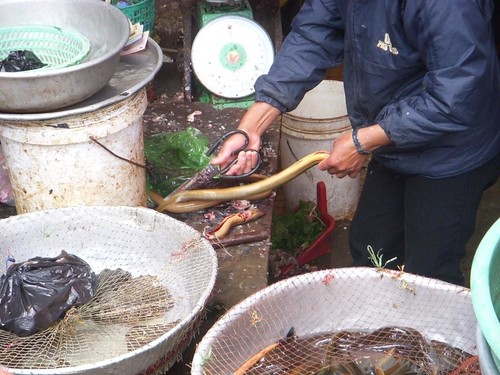
Fried eel on the dinner table. Yum! (We actually ate this dish 5 times in three days in Dalat!)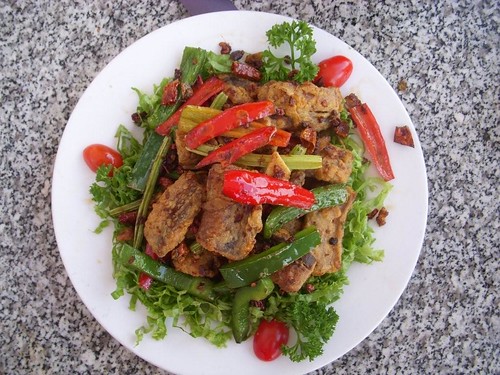 And here are some happy frogs, prior to having their heads scissored off by the mean market lady!
And here are some happy frogs, prior to having their heads scissored off by the mean market lady! And frogs on the dinner table
And frogs on the dinner table
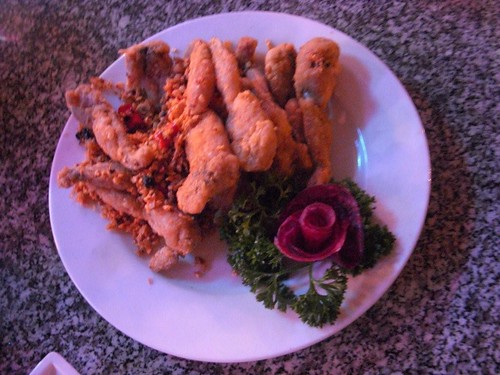
This is the common way that fresh seafood is presented in the restaurants - either on ice, or alive in tanks...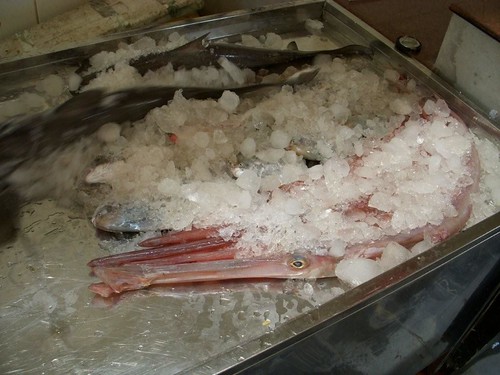
Lobster on the table in Mui Ne. We ordered this one from the tank on the street - and a few minutes later it came nicely grilled on the BBQ, seasoned with chili and garlic.
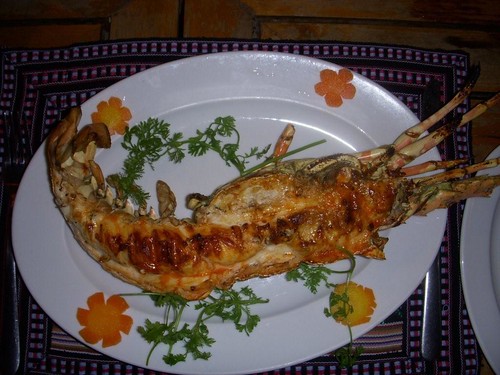
Other popular meat products include pork, chicken, and beef (we were told that 'beef' is often water buffalo which has outlived their usefulness dragging ploughs around the rice paddies - resulting in dark, tough meat called 'beef')... Much of the meat is available in the outdoor markets, with slabs of meat sitting on open wooden tables, in the heat, unrefrigerated, attracting flies... This is a common sight, which commonly suppressed our appetite for meat...
Here are some not-so-attractive chickens spread out on an open table at the Dalat market...
 And here are some various red meat products - including organs - again, out in the open. This picture was taken in Sapa where the climate is cooler - the scent of red meat sitting in the open in the hotter climates can sometimes become unbearable...
And here are some various red meat products - including organs - again, out in the open. This picture was taken in Sapa where the climate is cooler - the scent of red meat sitting in the open in the hotter climates can sometimes become unbearable...

Vietnamese Flavours: Spices, Herbs, and Sauces
Yum! Roots - various types of ginger and fresh turmeric - are used heavily in Vietnamese dishes, and of course garlic is a given (the large, sweet garlic which they call French garlic, and the small, pungent garlic, referred to as Vietnamese garlic)...
The first basket on the left carries both ginger and turmeric - the lighter root on the left is ginger (Vietnamese use two types of ginger - the larger, smoother root, and the smaller, more irregular-shaped, more pungent ones, which you see in the basket on the left) To the right of the ginger is the fresh turmeric, used to add color and flavor. In the West we mostly use turmeric in powder form... Fresh turmeric is also apparently used to stop bleeding if you hurt yourself... such as, you know, if you fall face-first off your pushbike in the middle of the street... for example.

The large basket in the front contains small pungent Vietnamese garlic. This picture was taken in front of one of the village houses that we visited. The garlic is sun-dried for their own consumption...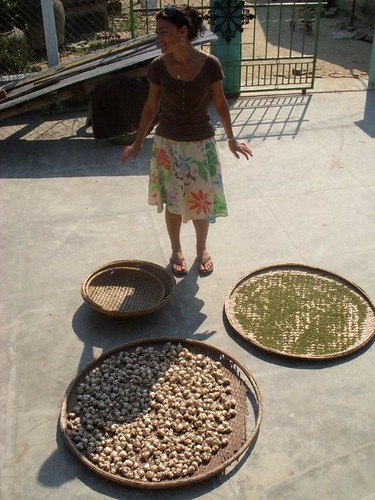
Lemongrass is also widely used in broths and sauteed and simmered dishes
Vietnamese rely heavily on fresh herbs for flavoring - particularly mint, basil, coriander/cilantro, chives, and spring onion... Mustard Green is another which is served as a condiment, as well as eaten with food... Again, these herbs are widely available in all the markets, presented fresh, beautiful, and of course, cheap, cheap, cheap...
These herbs aren't very distinguishable from each other here, but there are heaps and heaps of fresh, inviting herbs from mint to basil, from cilantro/coriander to basil and mustard green...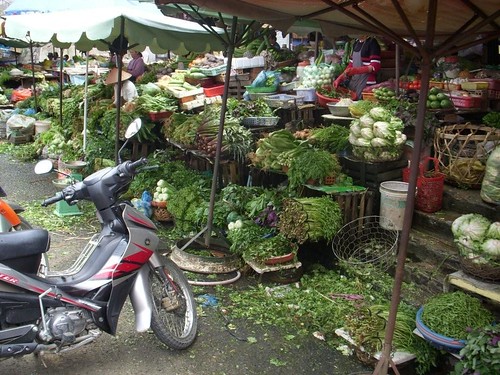
As soy sauce is the main ingredient for Chinese food, Nuoc Mam (a pungent fish sauce based on anchovies) is used in almost every dish for flavouring, and in many cases is used as a substitute for salt... Tamarind, a sour, pungent fruit, is ground into a paste, diluted, and used as a sauce for many dishes. It adds a nice sweet & sour flavor. Soy sauce is usually used as a condiment presented in a small bowl, to accompany dishes as they are served, not as a cooking ingredient. Lime is also used as both a condiment and an ingredient in many dishes...
Dried shrimp, shrimp paste, dried squid, and certain dried shredded fish (fish flakes) are sometimes sprinkled over salads and some appetizers to add texture and flavour.
Here are various dried squid and fish products, together with some commonly used spices...

Various fresh hot chili - both green and red - are used as both garnishes and spicing/heat element in many dishes
As far as dry spices goes, Chinese 5 Spices, nutmeg and both black and white pepper are the main spices. In some sauces and dishes, a dash or two of raw/brown sugar is used to balance the acidity and add flavors...
Here is a bundle of spices presented by one of the market vendors - dried turmeric, white pepper, black pepper, dried star anise, chili flakes...
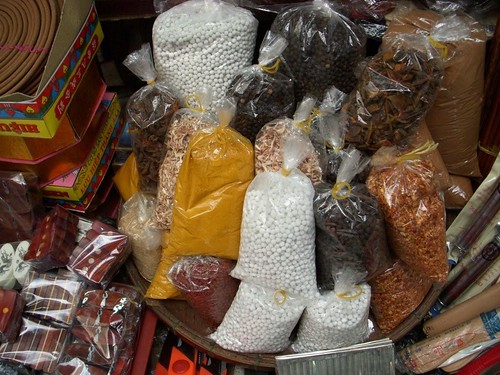
Cooking Methods and Meal Types
As everywhere, Vietnamese have a bunch of different cooking methods and meal types - from soups, which they refer to as pho, to noodle dishes, from simmering hotpot dishes, to BBQ/grill - they have it all.
The most common dish is pho (brothy soup) which can be chicken-based (pho ga), beef (pho bo), seafood, vegetables, etc. The broth is the most important element - this is where the mastery/flavour comes into play... They simmer beef, chicken, and/or pig bones for hours (if not a day) The resulting broth is graded based on its flavor and clarity... Lemongrass, fish sauce, garlic, onion, are all used in various combinations to flavor the broth. The next main ingredient is the noodle - mainly thin rice noodle. The meat (chicken/beef etc) is placed on top of the broth, after it is poured in a bowl with noodles. Garnish is then placed on top - basil, mint, hot chili pepper, green/spring onion. Pho also shows regional distinction - the three best known are those in the North (Hanoi), Central Vietnam (Hue) and South (Saigon). Almost every block, in every town, city and village has a pho stand or store-front restaurant. People in Vietnam eat pho as both a meal and/or snack - it is widely available and very very cheap.
Noodles aren't only used in soups - as in Chinese cuisine, Vietnamese consume a lot of stir-fries, saute and salads based on noodles. Again, variations depends on regions and seasonal ingredients. For example, in Danang / Hoi An area, they are known for their Cau Lau - "A textured wheat noodles mixed with veggies, bits of toasted rice paper, slices of pork and a wonderful light sauce... Interesting trivia... supposedly true cau lau cannot be made outside of Hoi An as the water for the dish must come from the Ba Le well, an ancient water hole hidden away in surprising spot, behind some very suburban houses."
This was the best Cau Lau that we had in Hoi An - again, at Morning Glory Cafe. We tried it at some Western hotels and it sucked...

Hotpots - simmered dishes
This is similar to Japanese Shaba-Shaba. Basically, you have a pot filled with broth or water placed on a portable hotplate which sits on your table. Plates with meat (seafood, chicken, beef or pork), vegetables (bean sprouts, mustard green, spinach etc), herbs (mint, basil, coriander, chives, green onion) are provided - and since it is mainly for group dining, everyone participates, mixing the ingredients in the simmering broth, adding various flavouring elements such as hot chili pepper, fish sauce and chili paste...
Here we are dining with our Vietnamese friend Le Ly Hayslip, over a traditional seafood hotpot. As you can see, to the right, is your fresh mix seafood as the main ingredients. In the center is the hotplate over which the pot of broth sits, simmering. To the left, is the mixed vegetable plate to go into the hotpot last, and some fresh herbs to be eaten raw with the meal (it is not always obvious which is which). As always, there is a bowl of rice vermicelli noodles as an accompaniment. What you can't see is a bowl of fresh, hot, hot, hot chili which we sprinkle over our meal once it is served for that needed heat element!

Others
Grilling and BBQ-ing are commonly employed methods - both at home and in restaurants. Since flavoring is very important, items are usually marinated first...
Frying is also used here and there - the Vietnamese usually use peanut oil for frying.
Salads
Salads are heavily and commonly consumed in Vietnamese cultures - from delicious green mango salad to banana flower salad. They are all delicately flavored , texturised in layers with great care, and artfully presented. The main flavoring elements are mint, basil, coriander, lime and lime juice... In some cases, seafood, pork, chicken or beef are included - along with crushed peanuts and/or sesame oil.
This is one of our many fave salads in Vietnam - Pomelo salad. It contains pomelo (a citrus fruit similar to grapefruit, but sweet), bean sprouts, spring onion, shrimp, mint, fried shallots, dried shrimp, hot chili pepper, a drizzle of lime juice, cane sugar, and fish sauce dressing. Absolutely yum.
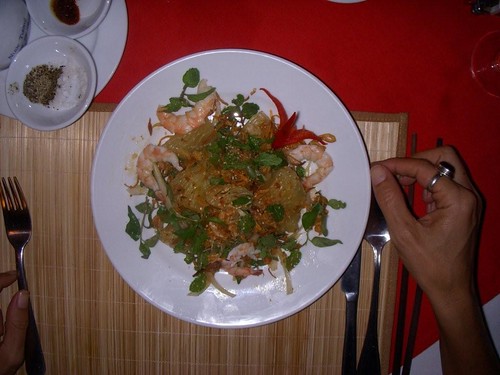
Deserts and Baked Goods
As far as the baked goods are concerned, the French influence is indubitably present. We have travelled extensively, but Vietnamese baguettes are by far the best we have ever come across. The breads, particularly the baguettes, are incredible - across the whole country.
Here is a not-so-great photo of the bakery at Cargo Club, one of our fave restaurants in Hoi An. Their baguettes were to die for...
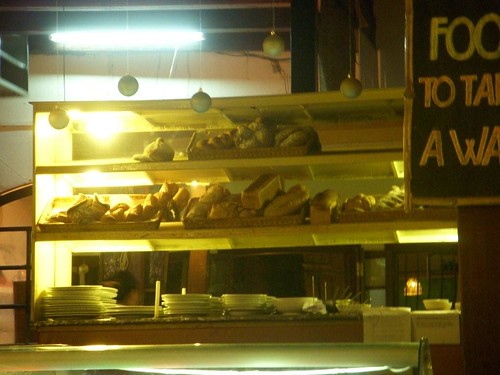
As far as traditional Vietnamese deserts are concerned, they can be broadly categorized as gelatinous - whether fried donuts filled with gelatinous fruits/fillings sold on the street corner, or steamed flavoured gelatin puddings in banana leaves...
Che is one of our favorite traditional Vietnamese street deserts - it's like a light pudding, with either corn, or mung bean, or tapioca base, served with lightly sweetened coconut milk and ice (the better restaurants always boasted of the fact that they made their own ice, and tried to convince us that we weren't eating the ice that we had just seen dragging down the street behind a motorbike!)
Here is the sweet corn and coconut milk che from Morning Glory Cafe. Here are some profiteroles - the French influence is quite obvious in Vietnamese food - but thankfully, mostly in a good way! These puff pastries are filled with light custard / cream, served cold, with a drizzle of chocolate sauce...
Here are some profiteroles - the French influence is quite obvious in Vietnamese food - but thankfully, mostly in a good way! These puff pastries are filled with light custard / cream, served cold, with a drizzle of chocolate sauce...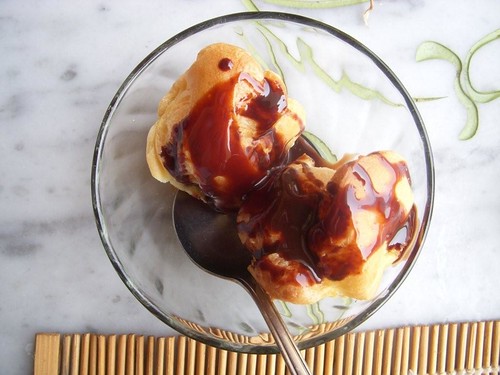
Presentation
Last but not least, the food here is always presented artfully, tastefully, and delicately. Every day we marvelled at the effort taken in presenting the food - whether it was a green mango salad sprinkled with golden brown crushed peanuts and decorated with fresh red chilli pepper sliced to represent a flower, or vegetables such as carrot, cucumber or tomato, cut and sculpted on the plate... Deep fried shallots are also frequently sprinkled over certain salads and appetizers for texture, flavour and color.
Obviously from the pictures of the food above, you already know that Vietnamese presentation of food is very artful and appetizing. Here is one more picture to convince you... Here is a dish of simply grilled shrimp. Simple it is not, right?!
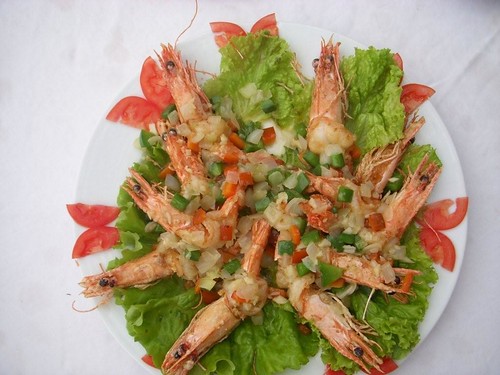
Next Up
Our adventures in cooking class at Morning Glory Restaurant in Hoi An...

